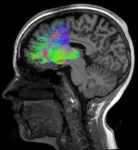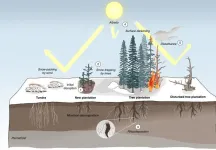(Press-News.org) CHAMPAIGN, Ill. — A University of Illinois Urbana-Champaign study is the first to describe an electrochemical strategy to capture, concentrate and destroy mixtures of diverse chemicals known as PFAS — including the increasingly prevalent ultra-short-chain PFAS — from water in a single process. This new development is poised to address the growing industrial problem of contamination with per- and polyfluoroalkyl substances, particularly in semiconductor manufacturing.
A previous U. of I. study showed that short- and long-chain PFAS can be removed from water using electrochemically driven adsorption, referred to as electrosorption, but this method is ineffective for ultra-short-chain molecules because of their small size and different chemical properties. The new study, led by Illinois chemical and biomolecular engineering professor Xiao Su, combines a desalination filtration technology, called redox electrodialysis, with electrosorption in a single device to address the problems associated with capturing the complete PFAS size spectrum.
The study findings are published in the journal Nature Communications.
“We decided upon redox electrodialysis because the very short-chain PFAS behave a lot like salt ions in water,” Su said. “The challenge was to produce an efficient, effective electrodialysis system to capture the ultra-short-chain PFAS, have it work in tandem with the electrosorption process for the longer-chain PFAS, destroy them with electrochemical oxidation, and make it happen within a single device.”
Su’s team has previously demonstrated highly efficient electrodialysis devices that remove various non-PFAS contaminants. However, the process requires ion-exchange membranes, which are expensive and quickly fouled by PFAS molecules.
To clear the membrane hurdle, Su’s team introduced an inexpensive nanofiltration membrane that enables the electric-field-driven removal of PFAS without becoming fouled. This technology is based on prior advances made by their group in combining redox polymers with these nanofiltration membranes to enable energy-efficient desalination.
For PFAS removal, having the right material for the job is one thing, but finding the most effective configuration is a significant challenge on its own.
“After experimenting with a variety of device configurations, we finally settled on a system that desalinates the PFAS-contaminated water to remove the ultra-short-chain molecules, then at the same time, carbon electrodes remove the remaining short- and long-chain molecules,” Su said. “This process also concentrates all the PFAS, making them easier to destroy once captured.”
Finally, the electrochemical oxidation process inherent to redox electrodialysis destroys the captured PFAS by converting them to fluoride ions, a key step towards eliminating these persistent contaminants from the environment.
Su said that the team is excited about the prospect of scaling up the process so they can take it out of the lab and into the field not only to address wastewater applications but also to incorporate the system on-site into industrial wastewater streams.
“This work is very timely due to interest from the U.S. government, wastewater treatment facilities and the semiconductor industry,” Su said. “Semiconductor production is expected to rise over the coming years, and PFAS abatement for sustainable production will become a major issue moving forward.”
Illinois researchers Nayeong Kim, Johannes Elbert and Ekaterina Shchukina contributed to this study. The National Science Foundation ERASE-PFAS program supported this research. Su also is affiliated with civil and environmental engineering, chemistry and the Beckman Institute for Advanced Science and Technology at the U. of I.
Editor’s notes:
To reach Xiao Su, call 217-300-0134; email x2su@illinois.edu.
The paper “Integrating redox-electrodialysis and electrosorption for the removal of ultra-short- to long-chain PFAS” is available online. DOI: 10.1038/s41467-024-52630-w.
Chemical and biomolecular engineering is part of the College of Liberal Arts and Sciences and The Grainger College of Engineering.
END
New PFAS removal process aims to stamp out pollution ahead of semiconductor industry growth
2024-11-07
ELSE PRESS RELEASES FROM THIS DATE:
Researchers identify reduction in heart failure-related risk factors following metabolic surgery
2024-11-07
Researchers Identify Reduction in Heart Failure-Related Risk Factors following Metabolic Surgery
Recent study suggests that metabolic surgery for patients with heart failure can reduce dependency on oral diuretics, which are used to manage heart failure symptoms
FOR IMMEDIATE RELEASE
November 7, 2024
BATON ROUGE – Pennington Biomedical Research Center researchers at the Metamor Institute, along with colleagues from Our Lady of the Lake and LSU Health-New Orleans, have recently determined that metabolic surgery on patients with heart failure can result in a reduction in the need for oral diuretics, which are used to manage symptoms such as venous and ...
The Kenneth H. Cooper Institute at Texas Tech University Health Sciences Center unveiled in Dallas
2024-11-07
For more than 50 years, as a leading pioneer of preventive medicine and the “father of aerobics,” Kenneth H. Cooper, M.D., has revolutionized health and fitness worldwide. Similarly, the Texas Tech University Health Sciences Center (TTUHSC) has long been dedicated to education, patient care and research. Today (Nov. 4) TTUHSC officially welcomed The Cooper Institute as part of its organization with a special presentation and unveiling of its new name – the Kenneth H. Cooper Institute at Texas Tech University Health Sciences Center.
The Cooper ...
DNA evidence rewrites story of people buried in Pompeii eruption
2024-11-07
In 79 AD, Mount Vesuvius experienced one of its most significant eruptions, burying the Roman city of Pompeii and its inhabitants under a thick layer of small stones and ash known as lapilli. Many of Pompeii's inhabitants lost their lives as their homes collapsed under the weight of the lapilli raining down from many kilometres above. Those who survived the initial phase of the eruption eventually succumbed to the dangerous pyroclastic flows. This fast-moving stream of hot gas and volcanic matter instantly enveloped their bodies in a solid layer of ash, effectively preserving their bodies, including their features.
Since the 1800s, casts had been made by pouring plaster into the ...
DNA evidence rewrites histories for people buried in volcanic eruption in ancient Pompeii
2024-11-07
In 79 CE, the active volcanic system in southern Italy known as Somma-Vesuvius erupted, burying the small Roman town of Pompeii and everyone in it. The “Pompeii eruption” covered everything in a layer of ash that preserved many of the bodies. Now, ancient DNA collected from the famed body casts alters the history that’s been written since the once forgotten town’s rediscovery in the 1700s. As reported on November 7, 2024, in Current Biology, the DNA evidence shows that individuals’ sexes and family relationships don’t match ...
People with schizophrenia show distinct brain activity when faced with conflicting information
2024-11-07
Scientists have known for decades that the classic symptoms of schizophrenia, such as jumping to conclusions or difficulty adjusting to new information, can be attributed to poor communication between the cerebral cortex and the thalamus, known as the brain’s central switchboard. By measuring brain cell activity between these two regions as volunteers completed ambiguous tasks, a team of Tufts University School of Medicine and Vanderbilt University School of Medicine researchers found a way to use someone’s sensitivity to uncertainty as a diagnostic tool.
In a study published November 7 in the journal ...
Climate change: Significant increase in carbon dioxide emissions from private aviation
2024-11-07
Annual emissions of carbon dioxide (CO2) from private aviation increased by 46% between 2019 and 2023, according to an analysis published in Communications Earth & Environment. The results also show that some individuals who regularly use private aviation may produce almost 500 times more CO2 in a year than the average individual, and that there were significant emissions peaks around certain international events, including COP 28 and the 2022 FIFA World Cup.
Private aviation is highly energy-intensive, emitting significantly more CO2 per passenger than commercial flights, but is used by approximately 0.003% ...
Planting trees in the Arctic could make global warming worse, not better, say scientists
2024-11-07
Tree planting has been widely touted as a cost-effective way of reducing global warming, due to trees’ ability to store large quantities of carbon from the atmosphere. But, writing in the journal Nature Geoscience, an international group of scientists argue that tree planting at high latitudes will accelerate, rather than decelerate, global warming.
As the climate continues to warm, trees can be planted further and further north, and large-scale tree-planting projects in the Arctic have been championed by governments and ...
Finding function for noncoding RNAs using a new kind of CRISPR
2024-11-07
Genes contain instructions for making proteins, and a central dogma of biology is that this information flows from DNA to RNA to proteins. But only two percent of the human genome actually encodes proteins; the function of the remaining 98 percent remains largely unknown.
One pressing problem in human genetics is to understand what these regions of the genome do—if anything at all. Historically, some have even referred to these regions as “junk.”
Now, a new study in Cell finds that some noncoding RNAs are not, in fact, junk—they are functional and play an important role in our cells, including in cancer and human development. Using CRISPR technology that ...
Neurodevelopment in the first 2 years of life following prenatal exposure to maternal SARS-CoV-2 Infection
2024-11-07
About The Study: In this longitudinal cohort study of multiple aspects of child neurodevelopment between ages 6 and 24 months, negligible associations between prenatal exposure to SARS-CoV-2 infection and child outcomes were observed. Follow-up research is warranted to determine whether these predominantly null effects persist into later childhood.
Corresponding Author: To contact the corresponding author, Gerald F. Giesbrecht, PhD, email ggiesbre@ucalgary.ca.
To access the embargoed study: Visit our For The Media website at this link https://media.jamanetwork.com/
(doi:10.1001/jamanetworkopen.2024.43697)
Editor’s ...
Racial disparities in genetic detection rates for inherited retinal diseases
2024-11-07
About The Study: Results from this study highlight a lower genetic detection rate for Black patients than for white patients with inherited retinal diseases. This supports a concern that the current development of inherited retinal disease therapeutics is highly dependent on the ability to identify the genetic cause of disease.
Corresponding Author: To contact the corresponding author, K. Thiran Jayasundera, M.D., email thiran@med.umich.edu.
To access the embargoed study: Visit our For The Media website at this link https://media.jamanetwork.com/
(doi:10.1001/jamaophthalmol.2024.4696)
Editor’s Note: Please see the article for additional information, including ...






